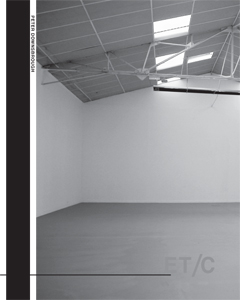Monograph with texts by Eva González-Sancho,
Michel Gauthier, Line Herbert-Arnaud and Richard Klein, exploring different aspects of Downsbrough's work (movies, maps, space...).
Since the mid-1970s, Peter Downsbrough has been at work on an open reading of the space surrounding us, through works for exhibitions (made with the help of black adhesive tape, tubes and letters) and public places, books and films, and maps that are so many promptings to the “renewed” experience of physical, urban, conceptual and “textual” space.
This publication comes in the wake of somewhat tardy monographs, tardy for an important work in art from these last few decades; it has been organised by the Palais des Beaux-Arts in Brussels in 2003 and the
Mamco in Geneva in 2004. The monograph by the Frac Bourgogne tries to approach little known aspects of Downsbrough's work, like his film-making, to which
Michel Gauthier devotes an essay, the use of maps - an essay by Line Herbert-Arnaud - and a “transversalization” - writes Eva González-Sancho - “which tallies with the space-time perspectives of the œuvre. Acting, then, in the space of the exhibition room, and in the space of the book, and in that of the city”, on which Richard Klein's essay dwells.
Also available, the DVD
ET/C.
The work of visual artist, photographer and film artist Peter Downsbrough (1940-2024)
has had a major impact on the perception of art. The varied work of the artist—ranging from sculpture and books to photography,
video, and film—maintained a complex relationship with architecture and
typography, while also drawing on the achievements of the early avant-garde
(Bauhaus, De Stijl) and Minimal Art.
In terms of form, the work of Downsbrough
is highly rigorous and exhibits a powerful geometric sense, restricting itself
primarily to the use of line, plane, negative space (cutting away), and
delimitation. In addition to his spatial manipulations, the artist also has
a keen interest in place, as is evidenced in his cartographical works and
city photographs.
Downsbrough studied architecture and art. Around the mid-1960s, after several years of work and exploring materials, an evolution took place with resulted, in 1970, in the work with the Two Pipes (outside), Two Dowels (inside), and Two Lines (on paper). At the same time, he also started taking photographs to document these pieces. Buy taking photographs of "cuts" that already existed in the urban landscape. Some of these photographs were used in books, some appeared in magazines, but it wasn't until 1960 that they showed up in exhibitions. From 1977 on, Downsbrough realized several videos as well as audiotapes. A record was made in 1978 and released in 1982. In 1980, on the Spectacolor Board on Times Square, N.Y., he realized a piece, a 30 second spot shown once every hour for four days and documented it in a short film, "7 come 11". The work with maquettes as a means of exploring space and structure started around 1983. The first commissioned public work was a wall piece realized in Rennes, France, 1990.
Texts by Eva González-Sancho,
Michel Gauthier, Line Herbert-Arnaud, Richard Klein.
Published by Frac Bourgogne.
published in 2005
bilingual edition (English / French)
19 x 24 cm (softcover)
88 pages (color & b/w ill.)
ISBN : 978-2-913994-17-1
EAN : 9782913994171
in stock


